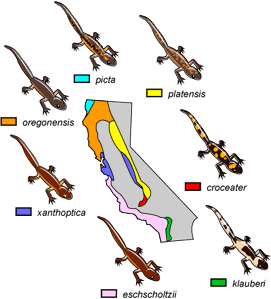 Last post, I introduced one of the classic examples of a ring species: the distribution of Ensatina species in California. Basically, Ensatina species are distributed in a great ring all around the Central Valley, with some species extending along the coastal ranges both north and south, and with other species distributed in the Sierra Nevadas. Just southwest of Bakersfield, the two ends of this species ring meet, provoking an interesting question: if different species exchange genes all along the ring, can the two ends of the ring interbreed?
Last post, I introduced one of the classic examples of a ring species: the distribution of Ensatina species in California. Basically, Ensatina species are distributed in a great ring all around the Central Valley, with some species extending along the coastal ranges both north and south, and with other species distributed in the Sierra Nevadas. Just southwest of Bakersfield, the two ends of this species ring meet, provoking an interesting question: if different species exchange genes all along the ring, can the two ends of the ring interbreed?
From decades of work, scientists have resolved a very clear picture of the geographic and genetic distribution of Ensatina (biologists who combine the study of geography and genetics call it phylogeography). Until the advent of molecular techniques, researchers relied on differences between coloration and morphology to identify different species. Now, this previous evidence is combined with molecular approaches that can measure the amount of gene flow between different lineages. It turns out that, sometimes, a classic species based on external features matches the patterns from protein and DNA sequences, which confirms previous taxonomic work. But, in some cases, a single species with the same external features may contain cryptic molecular lineages, which hints at a more complex evolutionary history.
So what happens when the two arms meet? Unlike the rest of the Ensatina species along the ring, the two ends are distinct enough (genetically, morphologically and/or behaviorally) to coexist without interbreeding. The Ensatina ring provides an example of speciation caught in the act: lineages along the ring still have enough gene flow to prevent speciation from fully occurring, but the two ends of the species gradient are distinct lineages with respect to each other, which allows them to share the same habitat without interbreeding. As better sampling and molecular techniques refine the picture of the Ensatina ring species, the pattern becomes much more complex, which has been attributed to the complex geological history of the environments in which the Ensatina lineages live. Ensatina diversification happened in conjunction with changes in the landscape of California, and so both evolutionary and geological histories are deeply connected.
Interestingly, the incipient speciation of Ensatina in California isn't a lone example; researchers have also found the same patterns in songbirds in northeastern Asia as well. Some of the best examples of evolution in action (like Darwin's finches in the Galapagos Islands) may be miles away, but sometimes you don’t have look much further than the leaf litter and logs in our own backyard.
![]() Nick Pyenson is a PhD candidate at the University of California, Berkeley, in the department of integrative biology and the museum of paleontology.
Nick Pyenson is a PhD candidate at the University of California, Berkeley, in the department of integrative biology and the museum of paleontology.
